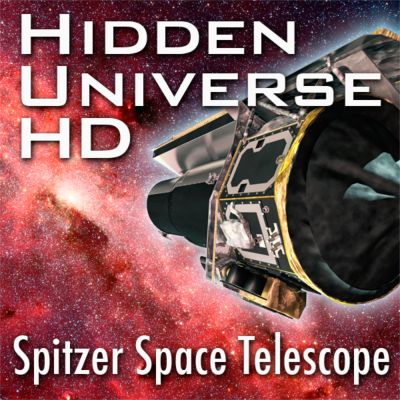Witness our universe in a whole new way! This video series highlights some of the most exciting discoveries from NASA's Spitzer Space Telescope. In-depth 'Showcase' features, striking 'Gallery Explorer' montages, and other whimsical specials take you beyond the visible to a universe of dust and stars hidden from Earth-bound eyes. Spitzer is the infrared component of the NASA Great Observatory program which also includes Hubble (visible), Chandra (x-ray), and Compton (gamma ray).
https://www.spitzer.caltech.edu/podcast/hidden-universe.xml
Gesamtlänge aller Episoden: 2 hours 40 minutes
The North America Nebula (Gallery Explorer)
Seen here in visible light, the North America Nebula strangely resembles its namesake continent. Expanding our view to include infrared light, the dark dust lanes and concealed stars glow in red colors while the continental gas clouds shift to an ocean-‐like blue. Pushing entirely into the infrared spectrum, we see even more detail in the convoluted dust clouds.
The Art of Exoplanets
While astronomers have identified over 500 planets around other stars, they’re all too small and distant to fill even a single pixel in our most powerful telescopes. That’s why science must rely on art to help us imagine these strange new worlds.
The Art of Exoplanets
While astronomers have identified over 500 planets around other stars, they’re all too small and distant to fill even a single pixel in our most powerful telescopes. That’s why science must rely on art to help us imagine these strange new worlds.
The Great Observatories Origins Deep Survey (GOODS)
Today's telescopes study the sky across the electromagnetic spectrum. Each part of the spectrum tells us different things about the Universe, giving us more pieces of the cosmic jigsaw puzzle. The most powerful telescopes on the ground and in space have joined forces over the last decade in a unique observing campaign, known as the Great Observatories Origins Deep Survey, or GOODS, which reaches across the spectrum and deep back into cosmic time.
The Great Observatories Origins Deep Survey (Special)
Today's telescopes study the sky across the electromagnetic spectrum. Each part of the spectrum tells us different things about the Universe, giving us more pieces of the cosmic jigsaw puzzle. The most powerful telescopes on the ground and in space have joined forces over the last decade in a unique observing campaign, known as the Great Observatories Origins Deep Survey, or GOODS, which reaches across the spectrum and deep back into cosmic time.
The Dragon and the Swan (Hidden Universe Gallery Explorer)
Hidden behind a dark veil of dust in the constellation Sagittarius, a lurking dragon has been revealed by the infrared eye of NASA’s Spitzer Space Telescope. It gives us a glimpse into how spiral arms affect the formation of stars.
The Dragon and the Swan (Gallery Explorer)
Hidden behind a dark veil of dust in the constellation Sagittarius, a lurking dragon has been revealed by the infrared eye of NASA’s Spitzer Space Telescope. It gives us a glimpse into how spiral arms affect the formation of stars.
When Worlds Collide (Showcase)
When worlds collide, the result is spectacular, and astronomers think they’ve detected the aftermath of such an event around another star.
When Worlds Collide (Showcase)
When worlds collide, the result is spectacular, and astronomers think they’ve detected the aftermath of such an event around another star.
The WISE Sky (Gallery Explorer)
In December of 2009, NASA launched its latest infrared telescope, the Wide-field Infrared Survey Explorer. This satellite, also known as WISE, is on a mission to map the entire sky in infrared light.
